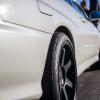Manual Or Electronic Boost
Boost Controller
11 members have voted
Announcements
-
Similar Content
-
Latest Posts
-
By TurboTapin · Posted
They are under bucket shims. Tomei provides a test shim kit and then any measurement of shim required. -
I always wondered how you were supposed to buy a set of 24 buckets and somehow magically have every single one of them yield exactly the desired clearance. I would have thought you'd need to assemble a cam with either 12 "sample" or "example" buckets of known top thickness (or a single such sample/example 12 times over!!) measure clearances at every valve, and then do the usual math to work out what the actual "shimness" of each bucket needed to be, before buying the required buckets to make up he thicknesses that you didn't have on hand.
-
By TurboTapin · Posted
I now seem to be limited in power due to my rev limit/hydraulic lifters in my built RB25. I'm looking into converting over to Tomei solid lifters. Question for anyone that has done the conversion. I was always under the impression that when using the Tomei solid lifter conversion, you would also require new valves (Longer or shorter stems, I can't remember which). I don't know where I got this idea, as so far I see no mention of this in any of the Tomei documentation. It just states I need the Tomei solid buckets, solid lifter cams and upgraded springs. As my head is already built, all I would need is another set of 1000$ Kelford cams, 500$ buckets and about 4H hours of my time installing and I'm off to the races!?!? There's no way it's that simple, I must be missing something? -
By TurboTapin · Posted
I couldn't agree more. I should have started from the get-go with a NEO or solid bucket conversion. I started looking into converting over to solid lifters yesterday. Now for some reason I was always under the impression that when using the Tomei solid lifter conversion, you would also require new valves (Longer or shorter stems, I can't remember which). But I see no mention of this on any of the Tomei documentation. It just states that I need the Tomei solid buckets, solid lifter cams and upgraded springs. As my head is already built, all I would need is another set of 1000$ Kelford cams, 500$ buckets and about 4H hours of my time installing and I'm off to the races!?!? There's no way it's that simple, I must be missing something?







Recommended Posts
Create an account or sign in to comment
You need to be a member in order to leave a comment
Create an account
Sign up for a new account in our community. It's easy!
Register a new accountSign in
Already have an account? Sign in here.
Sign In Now